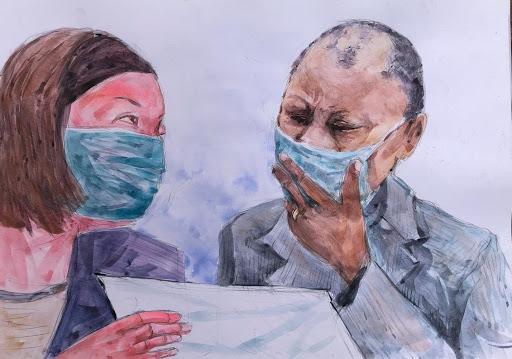Witness Protection at Special Court for Sierra Leone Under Scrutiny at Massaquoi Trial

Gibril Massaquoi consults with his lawyer in jail in Tampere, Finland from where he is joining hearings by videolink. Leslie Lumeh/New Narratives.
MONROVIA, Liberia - On day two of the return visit of the Finnish Court trying Gibril Massquoi for war crimes the focus continued to be on whether Massaquoi escaped the safe house in Freetown where he was under UN protection in exchange for informing on fellow combatants in Sierra Leone’s civil war.
Two witnesses in the court today claimed that “Angel Gabriel”, Massaquoi’s alleged war time alias, was in Waterside area of Monrovia during heavy fighting, commanding fighters with Sierra Leonean accents on behalf of then-President Charles Taylor in the dying days of the Liberian civil war.
“I saw Angel Gabriel many times,” said witness “X6” codenamed by the court to protect him from reprisals. “Sometimes once in a week I saw him, and he replaced Sam Bokari [another RUF commander] when he left. Benjamin Yeaten [a Taylor commander] introduced him as the commander replacing Sam Bokari.”
The witness, now 42, is a former fighter who claimed to have been recruited by General “Glassco”. He said he met Angel Gabriel at General Bokari’s house and on the war front. X6 said he stopped seeing Massaquoi when former President Taylor resigned and went into exile in Nigeria in August 2003.
The war crimes case is at a critical standpoint where the prosecution is trying to prove that Massaquoi escaped UN protection in Freetown to fight on behalf of one of the Special Court for Sierra Leone’s key suspects – President Taylor. The idea that a witness under UN protection could escape and commit war crimes in another country is a startling revelation. If the Finnish court finds that is what happened, it will have raise serious questions for the Special Court which convicted more than a dozen combatants from the Sierra Leone civil war.
“If new evidence determines that, though Massaquoi was a high-profile witness, his protection was porous—the next question would be, how wide spread was this practice?” asked Aaron Weah, an expert on transitional justice in Liberia and Sierra Leone.
“Transnational transitional justice processes can indirectly amount to a certain form of audit. Whether we like it or not, the Finnish Trial of Massaquoi is undertaking an audit of the Sierra Leone Special Court’s application of international law, particularly the practice and enforcement of its witness protection scheme. Like every audit, some transitions are determined to be legitimate and comply with the rules of audit and accounting, while others are determined to be non-compliant, violating the terms of generally accepted accounting principles. If the prosecution finds that Massaquoi witness protection scheme was violated on the watch of the Special Court monitoring, it raises a much bigger question about the Court’s integrity and how it impacted on certain outcomes.”
The first witness appeared very confident in his conviction that it was July and August 2003 that he saw Massaquoi despite defense efforts to question those dates. He told the court that Massaquoi, after LURD rebels had overtaken several areas from government forces and brought them to central Monrovia, was positioned at the old bridge connecting Vai Town and Waterside. LURD did not attack Monrovia until June 2003. He said other commanders including Generals “Salomie”, “Bull Dog” and “Michael High Grade” were also positioned in strategic places in central Monrovia while General Yeaten was at the E.J. Roye Building.
Describing the old bridge area where Massaquoi was based, the witness said he and his group were right under the bridge occupying a wide space.
“Under the bridge is a very wide space hat rocket could not even hit, and they were there cooking their dog meat and other foods,” he said in response to questions from Massaquoi’s defense lawyer Kaarle Gummerus during cross examination.
According to the witness, he came to know Angel Gabriel when he had taken over from Sam Bokari who was the head of Sierra Leonean mercenaries fighting for Taylor. In response to questions as to whether there were any other names by which the central character of this trial was known, the witness said no.
“I only knew him to be Angel Gabriel,” he said. “I was not assigned to him to know all about him. Only his Angel Gabriel name I knew and that’s what they used to call him by.”
The witness recounted that he and his commander Glassco visited Massaquoi’s based at Waterside and saw General Salomie killing a Liberian.
“When we saw that, General Glassco asked why the killing? And the killer said he was ordered by Angel Gabriel to carry on the execution,” the witness said. “The complaint was taken to General Benjamin Yeaten, but when he came, he told the soldiers to be focused because the war was going against them.”
The second prosecution witness, codenamed “X7” said he met Massaquoi on a diplomatic mission in Liberia. He said he got a truck belonging to Gibril Massaquoi and was driving it transporting RUF soldiers in Sierra Leone and at the same time goods from Sierra Leone to Liberia.
The Finnish court is in Liberia for the next two weeks. In coming days the court will prove the other key question that prompted its return to Liberia: defense allegations that prosecution witnesses were bribed to testify against Massaquoi by staff at the human rights group Global Research Justice Project.
This story is a collaboration with New Narratives as part of the West Africa Justice Research Project.
